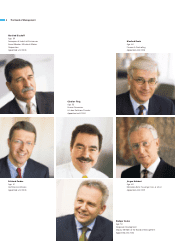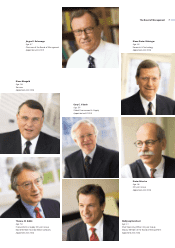Mercedes 2001 Annual Report Download - page 20
Download and view the complete annual report
Please find page 20 of the 2001 Mercedes annual report below. You can navigate through the pages in the report by either clicking on the pages listed below, or by using the keyword search tool below to find specific information within the annual report.
16 Executive Automotive Committee
Successful start for EAC. The Executive Automotive
Committee (EAC), which was formed at the beginning
of 2001 under the joint leadership of Jürgen E.
Schrempp and Jürgen Hubbert, has already introduced
several pioneering initiatives and has established itself
as an effective, efficient and goal-oriented instrument
for coordinating our global automotive business.
The activities of the EAC are intended to optimize
and strengthen the Group’s entire automotive business.
Enormous cost-reducing potential can be realized
through joint projects by the Group’s three automotive
divisions and our partner, Mitsubishi Motors, and
through the resulting knowledge transfer.
The variety of DaimlerChrysler’s brands is the
basis for us to selectively target our customers – and to
fulfill their individual wishes. In this context, the task
of the EAC is to secure the uniqueness and identity of
each individual brand.
To achieve this, the EAC concentrates on the
following areas of work:
- Coordinating and optimizing the product portfolio
- Identifying new technologies and innovations and
selecting the products and brands in which they will
be applied
- Standardizing components
- Steering the global production capacities of the
DaimlerChrysler Group
- Coordinating our global sales and marketing activities
Quick and flexible decisions. The EAC meets at
monthly intervals.
In the year 2001, 45 projects were defined and
analyzed, and reports on their progress were regularly
submitted to the Committee. 19 of these projects were
either already successfully completed in the first year
or are now in their final stages. There are examples of
the success of the EAC throughout its whole range of
activities.
Executive Automotive Committee:
driving the implementation process
■Key steering instrument for worldwide automotive business
■Preparation of cross-divisional decisions and initiatives
■Numerous projects defined and addressed; many already successfully completed
The overall steering of DaimlerChrysler’s automo-
tive business now takes place – with due consideration
being paid to our alliance partners – in accordance with
standard rules and processes. It is also an advantage
that cross-divisional projects are discussed in detail in
the EAC. This detailed coordination will enable us to
keep ahead of the competition with our next generation
of vehicles.
Product portfolio: cross-divisional segment strategy.
In some vehicle segments the foundations have already
been laid for the realization of synergies between the
various products of the Group. For example, engineers
from DaimlerChrysler and Mitsubishi Motors are work-
ing on a shared design concept for a small car in the
so-called B-segment. The smart four-seater and the two
Mitsubishi variants that are based on this platform are
to be launched as early as 2004.
Another decision was taken to develop a common
C-segment platform, with an estimated production
volume of more than 500,000 vehicles per year, for the
Chrysler Neon and the Mitsubishi Lancer and derived
product variants.
Chrysler Group and MMC have also defined a
third platform for full-sized sedans in the D-segment,
that is, for the successors to their Stratus/Sebring and
Galant models.
Definition of a long-term innovation calendar. A Group-
wide innovation plan has been prepared as a joint
project by the research and development departments.
On this basis, the EAC has prioritized and coordinated
the current innovation projects. The result is an innova-
tion calendar which defines when each innovation is to
be applied in which brand and in which product.
























